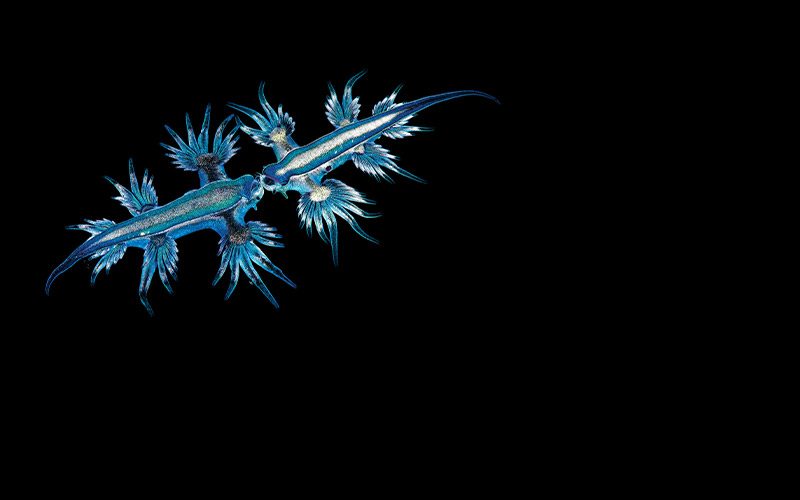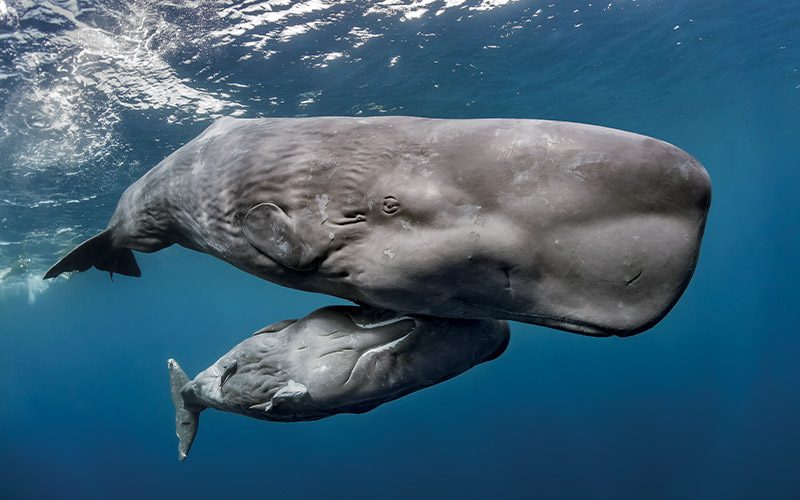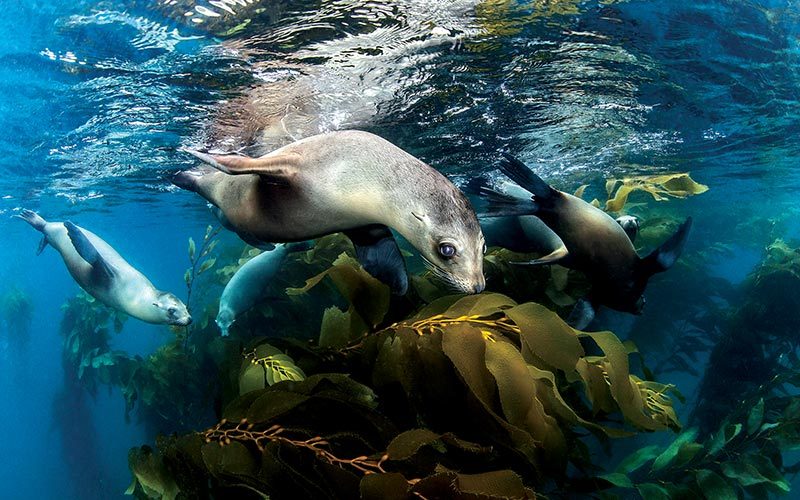I remember when I became aware that underwater photography had truly become mainstream. I was on a great white shark trip at Guadalupe Island, Mexico, with 19 other guests. The cruise director was briefing us on what to expect from the week, and he wanted to know how many underwater photographers were on board. I was accustomed to being one of five or six photographers on a boat, but on this trip 20 hands shot into the air. Wow, every single passenger on board was an underwater photographer.
The next day when I looked at the camera table I realized the approaches to underwater photography represented were numerous and varied. The assembled tools of the trade ranged from multi-thousand-dollar digital single-lens reflex (DSLR) cameras in extravagant aluminum housings to moderately priced point-and-shoot cameras in Ikelite polycarbonate housings. There were even iPhones in plastic bags. This was before SeaLife and GoPro cameras had begun to percolate so pervasively through the underwater imaging space, but even then the options were quite eclectic.
I think that’s when it hit me: Underwater photography is not about the cameras we buy, it’s about the passion we have. Each photographer was excited for his or her time in the cage and for the opportunity to get close to a great white shark. We were all eager to view the beauty of the sea and to share our vision and photographic execution with others.
We can share our discoveries via dive media such as Alert Diver and, most often, via social media. Facebook and Instagram are the new portals to underwater imaging, and on any given day the images that appear in my news feeds are spectacular.
Photo contests such as Ocean Views, run in partnership with Nature’s Best Photography magazine, are like social media on steroids. Not only will a wide audience get to view the winning photographs, but unlike the transitory “likes” an image might garner online, the prizes awarded to the winners are of great value — travel and equipment worth thousands of dollars, donated by our generous sponsors.
Congratulations to the photographers whose images have made it to these pages. Your photos have risen to the top of a fiercely contested field of extraordinary images. We honor your achievement, knowing all the while your greatest prize will have been the pure joy of the pursuit.
Grand Prize

Glaucus atlanticus
Tenerife, Canary Islands, Spain
By Eduardo Acevedo
Glaucus atlanticus is a venomous pelagic nudibranch that lives on the ocean’s surface and can be found all over the world, often in proximity to its prey, which includes Portuguese man-of-wars and other pelagic cnidarians as well as their own species if food is scarce. It took me nearly eight hours to find these inch-long specimens, which may have been mating or fighting, and another two hours to get the picture. Macro photography in the open ocean requires a calm sea and lots of patience.
Canon EOS 5D Mark II, Canon EF 100mm lens, 1/200 sec @ f/29, ISO 100, Inon Z-240 strobes (2), Seacam housing
First Place

Sperm Whale Mother and Calf
Dominica
By David Salvatori
The waters off Dominica’s west coast offer some of the best sperm whale encounters on the planet. Diving with the whales requires a permit, and the whales are typically skittish and difficult to approach. However, on three occasions during the week we met a curious and friendly group that included this mother and calf, which gave us incredible in-water encounters.
Nikon D800E, Sigma 15mm fisheye lens, 1/100 sec @ f/7.1, ISO 400, natural light, Seacam housing; www.ilmaresonoio.com
Second Place

California Sea Lions
Santa Barbara Island, Calif., USA
By Andy Sallmon
A group of curious California sea lion pups swims by in the shallow kelp forest canopy in the Channel Islands National Marine Sanctuary. Sea lions, especially young ones, are notorious for making high-speed passes, stopping only momentarily to bubble-bark at divers, coaxing them to join in the play.
Canon EOS 5D Mark III, Canon EF 8-15mm f/4L fisheye lens, 1/250 sec @ f/8, ISO 320, Sea & Sea YS-250 strobes (2), Sea & Sea housing; www.seait.com
Third Place

Siphonophores at Sunrise
Bushrangers Bay, Shellharbour, NSW, Australia
By Matty Smith
I had discovered in previous visits to this bay that strong summer winds from the northeast blow in and trap hundreds of bluebottles (also known as Portuguese man-of-wars). I began planning this shot with the idea that the orange of the rising sun would complement the blue animal nicely. It took many early mornings and lots of lighting experiments to finally capture this image.
Nikon D300S, Nikkor 10.5mm f/2.8 fisheye lens, 1/200 sec @ f/22, ISO 100, Inon Z-220 strobes (2), Aquatica AD300 housing with Aquatica 8-inch dome port; www.mattysmithphoto.com
Fourth Place

Juvenile Lemon Shark in Mangrove Forest
South Eleuthera Island, Bahamas
By Shane Gross
From the moment lemon sharks are born they are independent and capable of hunting. However, they are still small and vulnerable to predation themselves. Mangrove creeks provide protection from larger predators (including their own mothers) and plenty of food. One day the tide was extra high, submerging the mangrove leaves, and I captured this image of a shark among the leaves.
Nikon D90, Tokina 10-17mm f/3.5-4.5 fisheye lens at 10mm, 1/250 sec @ f/11, ISO 100, Sea & Sea YS-110a strobes (2) at ¾ power, Aquatica AD90 housing; www.grossphotographic.com
Fifth Place

Goby with Eggs on a Tunicate
Tulamben, Bali, Indonesia
By Aldo Costa
During a reef dive at Tulamben a beautiful blue tunicate caught my eye. As I approached I saw a goby above it, jealously guarding its eggs. The colors in the photographs I made did not stand out as I wanted, so the next day I returned with a snoot and made the image I had in mind.
Nikon D800, Nikon VR Micro-Nikkor 105mm lens, 1/250 sec @ f/16, ISO 100, Seacam Seaflash 150D strobe (1), Retra LSD Prime snoot, Seacam housing
Sixth Place

Diver in Kelp Forest
Catalina Island, Calif., USA
By Kyle McBurnie
Kelp, which may grow up to 2 feet per day, can transform an area into a dense forest within weeks. Last summer California experienced an influx of warm water, which made this site (Ship Rock) too warm for kelp, and the area is now bare. Such is life in the coldwater ecosystem; when conditions change we hope the kelp will return.
Olympus OM-D E-M5, Panasonic Lumix 8mm f/3.5 fisheye lens, 1/80 sec @ f/8, ISO 1000, Inon Z-240 and Sea & Sea YS-90DX strobes, Nauticam NA-EM5 housing; kylemcburnie.com

Seventh Place
Portuguese Man-of-War
Tenerife, Canary Islands, Spain
By Eduardo Acevedo
March and April are the best months to see these strange and beautiful animals in the Canary Islands. When the seas are calm and the sunlight is good, the conditions are right for good shots. In this image I tried to combine the clouds, the Portuguese man-of-war and the little juvenile pelagic fish.
Canon EOS 5D Mark II, Canon EF 15mm f/2.8 fisheye lens, 1/160 sec @ f/13, ISO 400, Inon Z-240 strobes (2), Seacam housing
Eighth Place

Blue Shark at Sunset
San Diego, Calif., USA
By Kyle McBurnie
Every year as the waters off San Diego cool we see an influx of blue sharks. There are fewer now than in decades past, and I consider myself lucky to have had encounters with three that day. As the sun set, this female was comfortable after sharing the water with us for several hours and was entranced by my camera as I managed this shot in the fading light.
Olympus OM-D E-M5, Panasonic Lumix 8mm f/3.5 fisheye lens, 1/125 sec @ f/5.6, ISO 640, Inon Z-240 and Sea & Sea YS-90DX strobes, Nauticam NA-EM5 housing; kylemcburnie.com

Ninth Place
At Water’s Edge
Barter Island, Alaska, USA
By Michael R. Henry
Until the winter sea ice arrives to allow the female polar bears and their cubs to leave Barter Island to hunt seals, there is little for them to do but wait. One day this first-year cub came to the water’s edge, where he stomped some snow, perhaps practicing to catch his first seal. Then he poked his nose into the water to find out how snow mixed with saltwater tastes.
Canon EOS 5D Mark III, Canon EF 500mm II f/4L lens, 1/2500 sec @ f/5, ISO 1250, hand held

Tenth Place
Spinner Dolphins Ascending
Kealakekua Bay, Kona, Hawaii, USA
By Ellen Cuylaerts
Last spring I traveled to Kona with Howard and Michele Hall. One afternoon the crew spotted a pod of spinner dolphins in Kealakekua Bay and dropped us there. In the water we could hear the dolphins before we saw them; the anticipation filled us with glee. As the dolphins rose from below us, I anticipated their upward movement toward Howard. I knew I couldn’t get as deep as the action, so I changed my settings to let in more light and went for a hazy, moody black-and-white image.
Nikon D800, Nikkor 16mm lens, 1/250 sec @ f/7.1, ISO 400, natural light, Nauticam housing; www.ellencuylaerts.com
Eleventh Place

Spinner Dolphin
Bonin (Ogasawara) Islands, Japan
By Toshio Minami
I took this photograph of a spinner dolphin leaping above calm waters in the Ogasawara Islands, a Pacific archipelago about 600 miles south of Tokyo. The dolphins swim offshore in the afternoons, and at sunset they begin to jump.
Canon EOS 5D Mark III, Canon EF 70-200mm f/4L IS USM lens at 97mm, 1/3200 sec @ f/7.1, ISO 200, hand held; www.facebook.com/ToshioMinami
Twelfth Place

Goby with Eggs on Sea Pen
Tulamben, Bali, Indonesia
By Aldo Costa
On a plateau of sand at about 30 feet I saw a lovely Pennatula sea pen. Knowing these often host small fish or crabs, I observed it closely and discovered a goby guarding its eggs. The incredible geometric precision with which the eggs were arranged was striking. Using a snoot I tried to get the top of the picture completely black to contrast with the bright red of the illuminated part of the image.
Nikon D800, Nikon VR Micro-Nikkor 105mm lens, 1/250 sec @ f/22, ISO 100, Seacam Seaflash 150D strobe (1), Retra LSD Prime snoot, Seacam housing
Highly Honored

Larval Lefteye Flounder
Kailua-Kona, Hawaii, USA
By Jeff Milisen
Because there is so little to hide behind in the nursery that is the pelagic ocean, one of the best defenses against visual predation is to have transparent organs and muscles. This larval lefteye flounder will spend the next few months hiding in the dark depths during the day and rising to the food-rich surface at night to feed.
Canon EOS Rebel T1i, Canon EF-S 60mm f/2.8 macro lens, 1/160 sec @ f/7.1, ISO 100, Ikelite DS51 strobes (2), Ikelite 500D housing; milisenphotography.yolasite.com

Highly Honored
Very Red
Anilao, Philippines
By Iyad Suleyman
I could hardly see this translucent juvenile goby with my naked eye because of its tiny size (approximately a half inch) and almost transparent body, which completely merged with the red color of whip coral. My experienced dive guide spotted the little gold-eyed fish, which I could only make out using a magnifier.
Canon EOS 70D, Canon EF 100mm f/2.8 macro lens, SubSee +10 and Saga +5 diopters, 1/160 sec @ f/10, ISO 100, Inon Z-240 strobes (2), Nauticam housing; www.facebook.com/pages/Iyad-Suleyman-Photography/347265398741600

Highly Honored
Emperor Penguins Through Ice
Snow Hill Island, Antarctica
By Linda Drake
Sea ice can form beautiful figures and caves, and I was lucky to find this piece at the edge of a penguin colony. I would position myself and hope for a penguin to come into view. Time is on the side of those who are willing to wait; so I waited, and finally the penguins arrived.
Canon EOS-1Ds Mark III, 70-200mm lens at 80mm, 1/320 sec @ f/22, ISO 400, hand held; www.LindaDrake.com
Highly Honored

Surfing Orca
Andenes, Lofoten Islands, Norway
By Paul Jackson
On the last morning of a trip to Norway, we found ourselves in very rough seas in the company of several pods of orcas. The boat hit a wave and plunged eight feet, soaking me and my camera in ice-cold water. As I wiped the ice from my face, I saw out the corner of my eye a breaking wave and an orca rising majestically through it.
Canon EOS-1D X, Canon EF 70-200mm f/2.8 IS II lens, 1/1000 @ f/2.8, ISO 1000, hand held

Highly Honored
Mating Seahorses
Phil Foster Park, Riviera Beach, Fla., USA
By Lureen Ferretti
Mating seahorses spend a lot of time courting, which includes swimming alongside one another and holding tails. At times they appear to be trumpeting, perhaps singing a tune I cannot hear. Finally they swim up into the water column several times to ensure proper alignment, and then the female deposits her eggs into the pouch of the male, who carries and eventually delivers them.
Canon EOS Rebel T1i, Canon 100mm macro lens, 1/200 sec @ f/10, ISO 100, Inon D-2000 strobes, Sea & Sea RDX-500D housing; www.deepwaterpics.com

Highly Honored
Lobster Phyllosoma on Jellyfish
Kona, Hawaii, USA
By Greg Lecoeur
I captured this image during a night dive in black water five miles offshore. Every night zooplankton migrates from the depths to feed at the surface. This larval lobster is preying on a pelagic jellyfish.
Nikon D7000, Nikon 60mm f/2.8 lens, 1/250 sec @ f/11, ISO 100, Ikelite DS160 strobes (2), Ikelite housing; www.greglecoeur.com

Highly Honored
Commensal Shrimp on Wire Coral
Pantar Island, Indonesia
By Liz Harlin
There was a strong current on this dive along a sloping wall, and in a calm eddy I chanced upon this half-inch shrimp living on a corkscrew-shaped section of wire coral. I wanted to show the shrimp in the context of its environment, so I included a lot of the coral in the frame. Corals play host to an assortment of well-camouflaged commensal shrimps, crabs and gobies.
Nikon D300, Nikon AF Micro-Nikkor 105mm f/2.8D lens, 1/125 sec @ f/22, ISO 200, Inon Z-240 Type 4 strobes (2), Subal ND30 housing, hand held; www.underseaproductions.com
Highly Honored

Hawksbill Sea Turtle
Little Cayman, Cayman Islands
By Sean Havas
Photographers’ camera domes probably resemble jellyfish, the favorite treat of the sea turtle. On this particular dive, this individual came toward me with its flippers outstretched, giving the impression of the turtle taking a “selfie.”
Nikon D800, Sigma 15mm f/2.8 fisheye lens, 1/200 sec @ f/20, ISO 800, Aquatica housing with Aquatica 6″ acrylic dome port, Ikelite DS160 strobes (2); www.seanhavas.com
© Alert Diver — Q2 2015